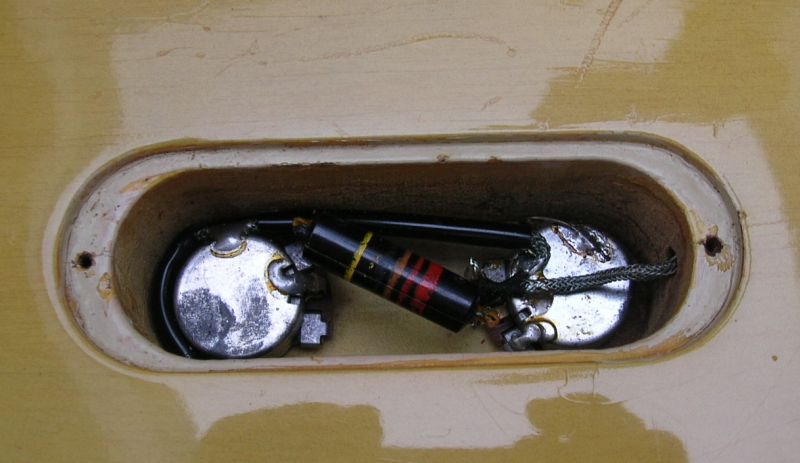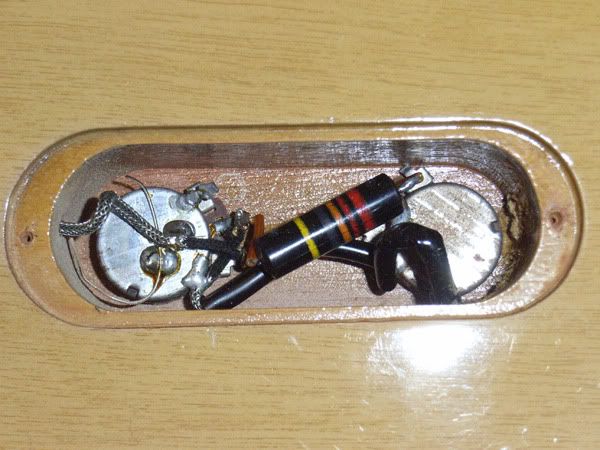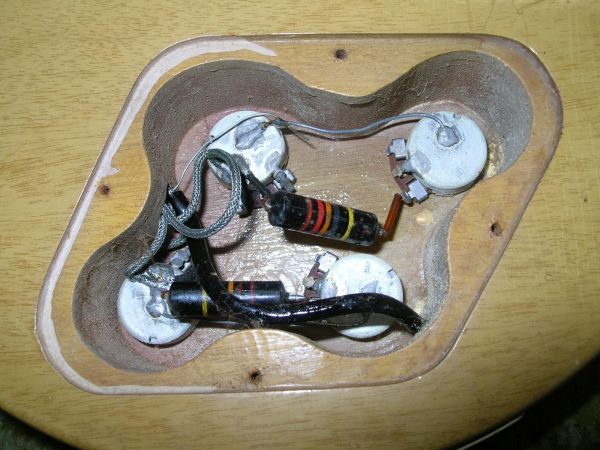Fred Hullerum
Member
- Joined
- Nov 3, 2008
- Messages
- 120
Up to
http://www.lespaulforum.com/forum/showpost.php?p=2108835&postcount=32
I did not know the values of the pots in my 60 TV. This posting gave me the information: The vol-pot is 500k, the tone-pot is 250k.
That seems to be quite unusual. But the more I think of it, the more it makes sense to me considering the important fact, that the "vintage wiring" was used. Here is a pic of the contol cavity of my TV (pic made by Tom).

You see "vintage wiring": The cap is soldered to the middle lug of the vol-pot.
I always wondered why my TV reacts so "magical" when reducing the volume.
When I first played my 1960 LP TV in the 80s I was struck by the behaviour of the volume pot.
I had expected the sound to become a little bit "dull" as it happens with all the other guitars when lowering the volume.
But this did not happen. The sound was still there - bright and belly.
I call this "magical".
Until recently I thought this to be a speciality of the "old P90" Pickup.
Now that I know the values of the pots, I see more clearly now.
Please let me share my theoretical ideas about the tonal effect of a vol.-pot with 500k and a tone-pot with 250k in addition with "vintage-wiring":
The combination of the capacitor and the tone pot is called a "filter".
It consists of a capacitor and a resistor.
The filter affects the "resonance-frequency" of the pickup.
It flattens the peak of the resonance-frequency and also decreases the location (in Hz) of this peak.
If the tone-pot is "10" the effect of the cap is minimum, because ground (GND) is "far away". The resonance frequency of the PU is not affected much.
If the tone pot is "1" the effect is maximum because GND is directly connected to the cap, in other words the cap is in paralled with the PU. You have a "woman tone".
(Later we discuss, what happens at "5".) Let us first assume the vol.-pot is "10":
Electronically now there is no difference between "modern" and "vintage" wiring. The PU is directly connected to the output jack.
The sound of the PU is not affected by the vol.-pot. (Yes, I know, the 500k of the volume-pot to GND are still there and this means something, but we can neglect that fact here.)
Let us assume the tone-pot is "10". Can we say, the sound now is also not affected? No.
The sound IS still affected, because the filter is still there, although the filter is not so "strong".
As the effect ist small, the guitar is "bright". BUT:
A little dampening effect is there: you have the cap and a resistor between the hot PU wire and GND.
I have learned that the effect of the filter in the LP jun. is "bigger" than for example in a LP Standard.
In a LP jun. at "10" the cap is only 250 kOhms away from GND.
In the LP Standard at "10" the cap is 500 kOhms - much more - away from GND.
That means:
The Gibson designers wanted the P90 to be "tamed", they wanted more "taming" for the P90 than for the humbucker.
(Interesting: The word "to tame" and the german word "zähmen" are the same old words.)
Why: Because the P90 is a "beast", a "treble-monster" - like the ones in the Stratocaster.
Such a "wild horse" has to be "tamed" even when all the knobs are at "10".
This "taming" is done with the 22nF cap and ONLY 250 kOhms to GND.
Has anybody tried to play a LP jun. with the filter disconnected?
I have not done that. I want to leave the soldering points in my TV original.
But I can assume: The sound of a P90, when (directly) plugged into a tube amp with at least 1 MegOhms input-impedance will sound "harsh". Biting treble that will damage your ear....
So what we call the "sound of the P90" is not the pickup alone.
Even all knobs at "10", the sound is a mixture of the PU and the filter (22 nF cap and 250 kOhms to GND).
Now I describe, the MAGIC that happens, when you keep the tone-pot at "10" and lower the vol-pot to "5".
All the text up to now was written for that purpose:
As I said before, at "10" there is no difference between "modern" and "vintage" wiring.
BUT: If you turn the vol.-pot to maybe "5", the filter becomes and acts different.
Assuming the vol.-pot is linear, then we have in "vintage wiring" 250k Ohms between the PU and the input of the filter.
Electronically the filter consists now
1. of the 250 kOhms of the vol.-pot
2. of the 22nF cap
3. of the 250 kOhms of the tone-pot.
Electronically it is not important what is where in the filter chain.
So we have: the 22nF cap and a (250+250=) 500 (!!) kOhms resistor.
Now the filter is EVEN MORE SMALLER than "normally" (with both pots at "10")!!
(This does not happen in modern wiring, because the filter is connected directly to the hot PU wire.)
That means: "Vintage wiring" is a great design!
As you turn down the volume, the guitar even becomes brighter!
So why did the Gibson designers use this feature?
They used this feature because of another effect, that I haven't explained yet:
Every PU becomes a little bit "dull" when reducing the volume on the guitar.
This is normal. The high impedance PUs react "stressed" on the "burden" of the volume pot.
"Vintage wiring" and the intelligent use of the mentionend values of the pots in the LP jun. COMPENSATE this "stress".
This technology provides the magical "bright" and "belly" sound when reducing the volume on the LP jun.
Fred
http://www.lespaulforum.com/forum/showpost.php?p=2108835&postcount=32
I did not know the values of the pots in my 60 TV. This posting gave me the information: The vol-pot is 500k, the tone-pot is 250k.
That seems to be quite unusual. But the more I think of it, the more it makes sense to me considering the important fact, that the "vintage wiring" was used. Here is a pic of the contol cavity of my TV (pic made by Tom).

You see "vintage wiring": The cap is soldered to the middle lug of the vol-pot.
I always wondered why my TV reacts so "magical" when reducing the volume.
When I first played my 1960 LP TV in the 80s I was struck by the behaviour of the volume pot.
I had expected the sound to become a little bit "dull" as it happens with all the other guitars when lowering the volume.
But this did not happen. The sound was still there - bright and belly.
I call this "magical".
Until recently I thought this to be a speciality of the "old P90" Pickup.
Now that I know the values of the pots, I see more clearly now.
Please let me share my theoretical ideas about the tonal effect of a vol.-pot with 500k and a tone-pot with 250k in addition with "vintage-wiring":
The combination of the capacitor and the tone pot is called a "filter".
It consists of a capacitor and a resistor.
The filter affects the "resonance-frequency" of the pickup.
It flattens the peak of the resonance-frequency and also decreases the location (in Hz) of this peak.
If the tone-pot is "10" the effect of the cap is minimum, because ground (GND) is "far away". The resonance frequency of the PU is not affected much.
If the tone pot is "1" the effect is maximum because GND is directly connected to the cap, in other words the cap is in paralled with the PU. You have a "woman tone".
(Later we discuss, what happens at "5".) Let us first assume the vol.-pot is "10":
Electronically now there is no difference between "modern" and "vintage" wiring. The PU is directly connected to the output jack.
The sound of the PU is not affected by the vol.-pot. (Yes, I know, the 500k of the volume-pot to GND are still there and this means something, but we can neglect that fact here.)
Let us assume the tone-pot is "10". Can we say, the sound now is also not affected? No.
The sound IS still affected, because the filter is still there, although the filter is not so "strong".
As the effect ist small, the guitar is "bright". BUT:
A little dampening effect is there: you have the cap and a resistor between the hot PU wire and GND.
I have learned that the effect of the filter in the LP jun. is "bigger" than for example in a LP Standard.
In a LP jun. at "10" the cap is only 250 kOhms away from GND.
In the LP Standard at "10" the cap is 500 kOhms - much more - away from GND.
That means:
The Gibson designers wanted the P90 to be "tamed", they wanted more "taming" for the P90 than for the humbucker.
(Interesting: The word "to tame" and the german word "zähmen" are the same old words.)
Why: Because the P90 is a "beast", a "treble-monster" - like the ones in the Stratocaster.
Such a "wild horse" has to be "tamed" even when all the knobs are at "10".
This "taming" is done with the 22nF cap and ONLY 250 kOhms to GND.
Has anybody tried to play a LP jun. with the filter disconnected?
I have not done that. I want to leave the soldering points in my TV original.
But I can assume: The sound of a P90, when (directly) plugged into a tube amp with at least 1 MegOhms input-impedance will sound "harsh". Biting treble that will damage your ear....
So what we call the "sound of the P90" is not the pickup alone.
Even all knobs at "10", the sound is a mixture of the PU and the filter (22 nF cap and 250 kOhms to GND).
Now I describe, the MAGIC that happens, when you keep the tone-pot at "10" and lower the vol-pot to "5".
All the text up to now was written for that purpose:
As I said before, at "10" there is no difference between "modern" and "vintage" wiring.
BUT: If you turn the vol.-pot to maybe "5", the filter becomes and acts different.
Assuming the vol.-pot is linear, then we have in "vintage wiring" 250k Ohms between the PU and the input of the filter.
Electronically the filter consists now
1. of the 250 kOhms of the vol.-pot
2. of the 22nF cap
3. of the 250 kOhms of the tone-pot.
Electronically it is not important what is where in the filter chain.
So we have: the 22nF cap and a (250+250=) 500 (!!) kOhms resistor.
Now the filter is EVEN MORE SMALLER than "normally" (with both pots at "10")!!
(This does not happen in modern wiring, because the filter is connected directly to the hot PU wire.)
That means: "Vintage wiring" is a great design!
As you turn down the volume, the guitar even becomes brighter!
So why did the Gibson designers use this feature?
They used this feature because of another effect, that I haven't explained yet:
Every PU becomes a little bit "dull" when reducing the volume on the guitar.
This is normal. The high impedance PUs react "stressed" on the "burden" of the volume pot.
"Vintage wiring" and the intelligent use of the mentionend values of the pots in the LP jun. COMPENSATE this "stress".
This technology provides the magical "bright" and "belly" sound when reducing the volume on the LP jun.
Fred





